Friday, April 22, 2022 | Written by Claire
Trains. They’re what make Europe run the way it does today. From local to region to cross-country high speed trains, there are so many different designs and engineering feats you will encounter everywhere you travel. As a newcomer to European transportation before this semester, I found the intricate time tables of arriving and departing trains, engineering mechanisms of high speed rail, and designs to be highly fascinating. From the hundreds of trains I’ve ridden in this past semester, here are my top 5 favorites. If you get the chance, definitely use your Eurail pass to your advantage and take a luxury train ride across the country of your desire.
5: TGV (France)
This train is going to be your best friend. The good ol’ TGV, also known as Train à grande vitesse, or high-speed train in French. This is the French intercity rail line that will be the heart of how you travel in, out, and within France. There are many other trains that follow the design of the TGV, but this is the original, fastest rail-based high speed train developed in the world, traveling up to 300 km per hour. While TGVs are not the most luxurious on the inside compared to many other trains, it is definitely a classic exterior that represents France as a whole. 
4: Italo Treno (Italia)
To me, this train is like a Ninja. Flanked by red and black stripes, the design of this train embodies speed, agility, and precision. With a nose slightly sharper than many of the ICE and TGV trains, it creates a narrow, streamline figure that cuts through air as it races down the tracks. It is also eco-friendly and sustainable, a good move towards Italy’s renewable energy plan. The interior also has several sections, one that is more “first class” that comes with unlimited snacks and private suites. The seats themselves are firmly cushioned for comfort. Bathrooms are kept squeaky clean and table space is generous.
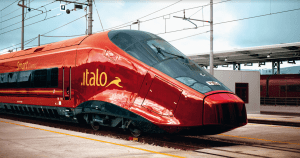
3: ICE (Germany)
I’ve spent most of my travel days on ICE trains simply for its convenience, reliability, and comfort. While it can be packed as the summer months approach, the ICE train is the German high speed rail line that is designed to get you across the country in a matter of hours. If timed right, you can take them as overnight trains and save a few bucks on hotel costs. For the winter, these trains are definitely safe havens for warmth and shelter among the blistering cold winds outside. The seating cushion is also one of the most comfortable. With pillowed head rests and curved back spaces, you can comfortably sleep without leaning your head on a stranger’s shoulder. Additionally, ICE trains have adequate luggage racks at the end and above seats to actually fit your backpack and not just a jacket like some of the French TGVs.
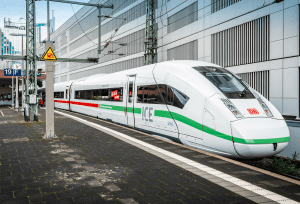
2: Südostbahn Traverso (Switzerland)
Deemed as what my friend calls the “sexy train,” the Südostbahn, often abbreviated as SOB, is the new design for the regional Swiss railcar. Plated with a rose gold chrome roof and side matting, the Traverso features spacious seating, large window space, and noise canceling interior. Many of the regional lines also go through scenic routes, making the train ride even more enjoyable. Not only is it kept clean and hygienic, the train also has a bistro car for certain food options and even a vending machine in several cars where you can grab instant coffee or soda. Additionally, while most train bathroom cars are filthy and often smelly, the Traverso has a huge and luxurious bathroom with high pressure faucets and good mirror lighting as well. This was by far one of my favorite train rides I’ve been on and one the most sleek exterior designs within European trains.

1: Thalys (French-Belgium)
For me, the Thalys will always have a special place in my heart. Branded as an entirely red train, the sleek design makes Thalys standout among the mass of trains passing through each station. They are characterized by their bright red exterior, flanked with silver. Thalys are one of the most expensive trains to ride and they only run through specific cities as well. This French-Belgian line runs high speed trains from Paris, Amsterdam, Brussels, and Cologne. Interior-wise, spacious seating with adequate working room and quadded table space make it easily one of the most comfortable trains to ride.


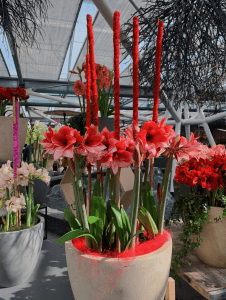 Warmth. As the sun began to filter through the trees, the first signs of Spring emerged as tiny flower buds nestled within the greening grass and started peeking out from the crackly tree branches. In Metz and across Europe, a myriad of colors began to paint the cold, bleak canvas left by winter.
Warmth. As the sun began to filter through the trees, the first signs of Spring emerged as tiny flower buds nestled within the greening grass and started peeking out from the crackly tree branches. In Metz and across Europe, a myriad of colors began to paint the cold, bleak canvas left by winter. 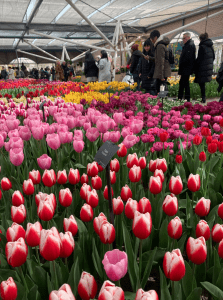
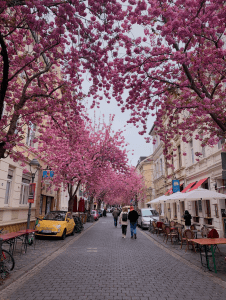 This glorious stretch of cherry blossom was just a random find when we visited Bonn, Germany.
This glorious stretch of cherry blossom was just a random find when we visited Bonn, Germany. 

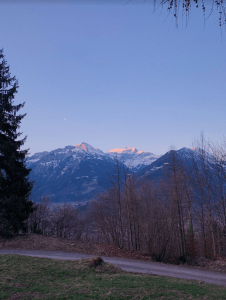 At first, our journey was smooth, we were able to catch a glimpse of the beautiful sunrise as it shimmered across the lake and reflected off the snow-covered mountains across from us. Preparation wise: we really loaded up on food. With 3L of water for each of us, a dozen or so ham sandwiches, 12 granola bars, a pack of Biscoff, 2 fruit squeezies, and a pack of Dutch Nutella cookies, we were set. However, in terms of gear, only one of us had hiking sticks and the rest of us managed to get around using regular school backpacks, tennis shoes, and our overall balance. That was where we made a grave mistake.
At first, our journey was smooth, we were able to catch a glimpse of the beautiful sunrise as it shimmered across the lake and reflected off the snow-covered mountains across from us. Preparation wise: we really loaded up on food. With 3L of water for each of us, a dozen or so ham sandwiches, 12 granola bars, a pack of Biscoff, 2 fruit squeezies, and a pack of Dutch Nutella cookies, we were set. However, in terms of gear, only one of us had hiking sticks and the rest of us managed to get around using regular school backpacks, tennis shoes, and our overall balance. That was where we made a grave mistake. 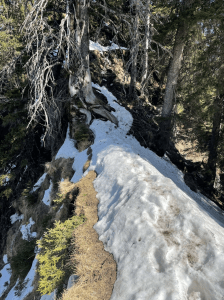 The trails became narrower and the ridge even steeper, with two sharp drops on both sides. We were ill-prepared to take on the trail any longer. When we were almost about the clear the trees, several experienced hikers had turned back, warning us that the ridgeline would be too snowy to continue, but we were determined to check out the scene for ourselves. Long story short- we turned back. The sharp drop was covered in packed, melting snow, the most dangerous combination. With our lack of equipment and expertise, we had to give up the hike. It was just too early in the year to reach Augstmatthorn.
The trails became narrower and the ridge even steeper, with two sharp drops on both sides. We were ill-prepared to take on the trail any longer. When we were almost about the clear the trees, several experienced hikers had turned back, warning us that the ridgeline would be too snowy to continue, but we were determined to check out the scene for ourselves. Long story short- we turned back. The sharp drop was covered in packed, melting snow, the most dangerous combination. With our lack of equipment and expertise, we had to give up the hike. It was just too early in the year to reach Augstmatthorn. 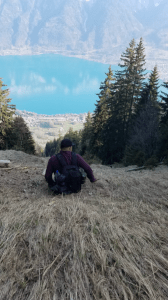 Slowly inching our way down, we were able to scoot slowly over the grass, with one of two terrifying moments when we would lose control over patches of slippery grass, grabbing desperately onto the weeds for some stability. In the end, after 40 miserable minutes of sliding, slipping, and sprawling on the ground to slow our descent, we made it to a flatter ledge on the side. Just getting to the ledge was difficult enough, spreading into a sea star and grabbing the small tree saplings to pull us over to safety. Finally, we had made it. Miraculously, just several meters away was flat ground that looked relatively clear of snow and mud. The trail. Somehow, we had made it to the same trail just further down the mountain, saving us a hundred meters or so of downhill hiking. From there, we hustled down the mountain, almost running as we heard strange animal sounds and breaking branches coming from deep within the forest. After another hour, we collapsed onto the pavement, relieved, exhausted, and elated to be one step closer to home… sike.
Slowly inching our way down, we were able to scoot slowly over the grass, with one of two terrifying moments when we would lose control over patches of slippery grass, grabbing desperately onto the weeds for some stability. In the end, after 40 miserable minutes of sliding, slipping, and sprawling on the ground to slow our descent, we made it to a flatter ledge on the side. Just getting to the ledge was difficult enough, spreading into a sea star and grabbing the small tree saplings to pull us over to safety. Finally, we had made it. Miraculously, just several meters away was flat ground that looked relatively clear of snow and mud. The trail. Somehow, we had made it to the same trail just further down the mountain, saving us a hundred meters or so of downhill hiking. From there, we hustled down the mountain, almost running as we heard strange animal sounds and breaking branches coming from deep within the forest. After another hour, we collapsed onto the pavement, relieved, exhausted, and elated to be one step closer to home… sike.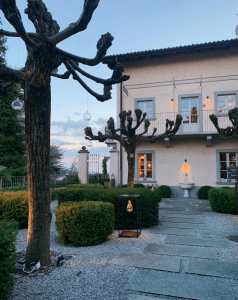 As the sun rose high in the sky, I was delighted to feel the warm rays bathed across my face and the fresh breeze. It was a definite change up from the weather in Metz, where it was perpetually grey and gloomy seven days a week. The city itself was beautiful. The town was lined with colorful houses of pastel orange, yellow, and red. The small little alleyways of the quaint Italian town seemed to emerge from stone, stacked upon each other creating small winding trails on the cliffs above the water, which shimmered a beautiful crystal-turquoise color as small private boats settled on the surface, rocking peacefully back and forth. Although the trees were still on their early spring phase, the leaf-less branches created intricate shapes and patterns that weaved higher in the sky, a natural masterpiece.
As the sun rose high in the sky, I was delighted to feel the warm rays bathed across my face and the fresh breeze. It was a definite change up from the weather in Metz, where it was perpetually grey and gloomy seven days a week. The city itself was beautiful. The town was lined with colorful houses of pastel orange, yellow, and red. The small little alleyways of the quaint Italian town seemed to emerge from stone, stacked upon each other creating small winding trails on the cliffs above the water, which shimmered a beautiful crystal-turquoise color as small private boats settled on the surface, rocking peacefully back and forth. Although the trees were still on their early spring phase, the leaf-less branches created intricate shapes and patterns that weaved higher in the sky, a natural masterpiece. 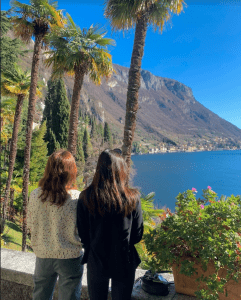
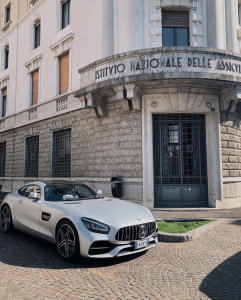 Finally, in Bellagio, we hopped off the ferry right on time to catch the glorious sunset, a ball of bright red that dipped below the horizon. As the sun disappeared, the cold started to set in, coupled with the strong winds that ripped our hair back and forth. As we took a look at the time, we would be right on time to catch the last bus back to the train station in Varenna, which would bring us back to the hotel. We stood in the dark corner of the bus station, waiting as the time ticked past its scheduled arrival. As the moon continued to rise higher into the sky, the bus finally showed up, only to be packed to the BRIM with passengers huddled like sardines on board. There was no room to spare. The driver, however, didn’t even stop; instead, we took one look at our shivering selves at the bus station, shrugged, and sped away. Our hearts sank. There was no way back. We stood there in silence for a minute pondering on what to do, but not too far from the dock, we saw a ferry pulling up to the station. It seemed to be running on schedule despite the strike. At once, we bolted on board only to find twenty other people trying to get to the same train station to catch the next train that would supposedly leave 5 minutes after the ferry arrives.
Finally, in Bellagio, we hopped off the ferry right on time to catch the glorious sunset, a ball of bright red that dipped below the horizon. As the sun disappeared, the cold started to set in, coupled with the strong winds that ripped our hair back and forth. As we took a look at the time, we would be right on time to catch the last bus back to the train station in Varenna, which would bring us back to the hotel. We stood in the dark corner of the bus station, waiting as the time ticked past its scheduled arrival. As the moon continued to rise higher into the sky, the bus finally showed up, only to be packed to the BRIM with passengers huddled like sardines on board. There was no room to spare. The driver, however, didn’t even stop; instead, we took one look at our shivering selves at the bus station, shrugged, and sped away. Our hearts sank. There was no way back. We stood there in silence for a minute pondering on what to do, but not too far from the dock, we saw a ferry pulling up to the station. It seemed to be running on schedule despite the strike. At once, we bolted on board only to find twenty other people trying to get to the same train station to catch the next train that would supposedly leave 5 minutes after the ferry arrives.